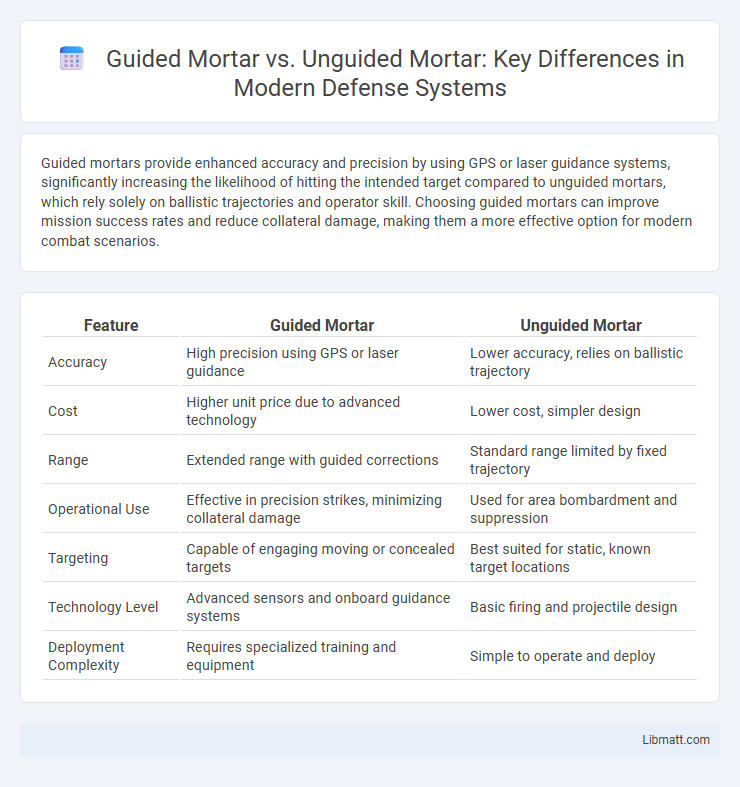Guided mortars provide enhanced accuracy and precision by using GPS or laser guidance systems, significantly increasing the likelihood of hitting the intended target compared to unguided mortars, which rely solely on ballistic trajectories and operator skill. Choosing guided mortars can improve mission success rates and reduce collateral damage, making them a more effective option for modern combat scenarios.
Table of Comparison
| Feature | Guided Mortar | Unguided Mortar |
|---|---|---|
| Accuracy | High precision using GPS or laser guidance | Lower accuracy, relies on ballistic trajectory |
| Cost | Higher unit price due to advanced technology | Lower cost, simpler design |
| Range | Extended range with guided corrections | Standard range limited by fixed trajectory |
| Operational Use | Effective in precision strikes, minimizing collateral damage | Used for area bombardment and suppression |
| Targeting | Capable of engaging moving or concealed targets | Best suited for static, known target locations |
| Technology Level | Advanced sensors and onboard guidance systems | Basic firing and projectile design |
| Deployment Complexity | Requires specialized training and equipment | Simple to operate and deploy |
Introduction to Mortar Systems
Mortar systems include guided and unguided variants, with guided mortars incorporating advanced targeting technology like GPS or laser guidance to improve accuracy and reduce collateral damage, whereas unguided mortars rely on ballistic calculations and manual aiming. Guided mortar rounds enhance the precision of indirect fire, allowing Your forces to engage targets with fewer rounds and increased lethality in complex combat environments. The integration of sensors and guidance kits transforms traditional unguided mortars into smart weapons, significantly improving operational effectiveness on the battlefield.
Fundamentals of Guided Mortars
Guided mortars incorporate advanced targeting technology such as GPS, laser guidance, or inertial navigation systems to enhance accuracy and reduce collateral damage compared to traditional unguided mortars. These smart munitions adjust their flight path mid-course to reliably hit precise coordinates, improving effectiveness in dynamic battlefield conditions. Understanding the fundamentals of guided mortars helps optimize your deployment strategy by leveraging their superior precision and adaptability.
Key Features of Unguided Mortars
Unguided mortars are characterized by their simplicity, cost-effectiveness, and ease of use in various combat scenarios. They rely solely on ballistic trajectories without any onboard guidance systems, resulting in less precision compared to guided mortars. Their robustness and rapid deployment capabilities make them essential for infantry units requiring indirect fire support over short to medium ranges.
Technology Behind Guided Mortar Precision
Guided mortars use advanced GPS, laser, or infrared guidance systems to achieve pinpoint accuracy, significantly reducing collateral damage and increasing target effectiveness compared to traditional unguided mortars that rely solely on ballistic calculations. Sensor fusion technology integrates real-time data to adjust the mortar's trajectory mid-flight, ensuring greater precision even in dynamic battlefield conditions. Your ability to deploy guided mortar rounds means enhanced operational efficiency and improved safety for allied forces and civilians.
Range and Accuracy Comparison
Guided mortars offer significantly enhanced range and accuracy compared to unguided mortars, using advanced GPS and laser guidance systems to ensure precise targeting over extended distances, often exceeding 7 kilometers. Unguided mortars rely purely on ballistic trajectories, limiting effective range typically to 3-5 kilometers and increasing the likelihood of collateral damage due to less precision. Your choice between these systems will depend largely on mission requirements for precision strikes versus cost-efficiency.
Operational Effectiveness in Combat
Guided mortars significantly enhance operational effectiveness in combat by providing precision targeting, reducing collateral damage, and increasing hit probability against moving or fortified targets. Unguided mortars rely on ballistic trajectories and operator estimates, often requiring multiple rounds to achieve desired impact, which can slow down engagement speed and increase ammunition expenditure. Your ability to quickly neutralize threats with guided mortars improves overall battlefield efficiency and troop safety during operations.
Cost and Logistics Considerations
Guided mortars typically involve higher upfront costs due to advanced targeting technology and precision guidance systems, whereas unguided mortars are more cost-effective with simpler manufacturing and maintenance requirements. Logistically, guided mortars demand specialized training, sophisticated support equipment, and secure supply chains for guidance components, increasing operational complexity compared to the straightforward resupply and deployment of unguided mortar rounds. Your choice between guided and unguided mortars will impact budget allocation and logistical strategies, balancing precision benefits against cost and support infrastructure constraints.
Tactical Flexibility and Deployment
Guided mortars offer enhanced tactical flexibility through precision targeting, enabling rapid engagement of moving or high-value targets with minimized collateral damage. Their capability to integrate with advanced targeting systems allows for deployment in complex combat environments, reducing the need for extensive forward observer coordination. Unguided mortars, while simpler and quicker to deploy, rely heavily on area saturation and pre-planned firing data, limiting adaptability in dynamic battlefield scenarios.
Recent Developments in Mortar Guidance
Recent developments in mortar guidance have significantly improved battlefield accuracy and lethality by integrating GPS and laser guidance systems into traditional mortar rounds. Guided mortars now offer precision targeting capabilities, reducing collateral damage and increasing the effectiveness of fire support compared to unguided mortars, which rely solely on ballistic trajectories. Your forces can benefit from these advancements by employing guided mortars to enhance mission success rates in complex combat environments.
Future Trends in Mortar Warfare
Future trends in mortar warfare emphasize the increasing adoption of guided mortar systems that enhance precision strike capabilities, reduce collateral damage, and improve operational effectiveness in complex combat environments. Technological advancements such as GPS guidance, laser designation, and real-time targeting data integration are transforming traditional unguided mortars, which rely solely on ballistic trajectories and often require multiple rounds for target neutralization. These innovations are driving military forces worldwide to invest in smart munitions that increase lethality, minimize ammunition expenditure, and offer greater flexibility in urban and asymmetrical warfare scenarios.
guided mortar vs unguided mortar Infographic

 libmatt.com
libmatt.com